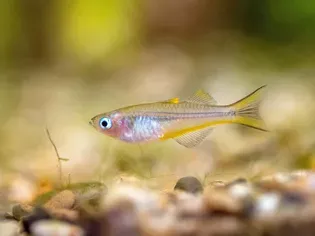Forktailed Rainbowfish Species Profile
Updated on 04/26/24

Dive into the Enchanting World of Forktailed Rainbowfish: A Comprehensive Species Profile
Introduction
Prepare to be captivated by the mesmerizing Forktailed Rainbowfish, a vibrant and alluring species that adorns the freshwater ecosystems of Australia and New Guinea. Known for their iridescent hues, graceful movements, and social nature, these fish have become a beloved addition to home aquariums worldwide. In this comprehensive species profile, we delve into every aspect of their biology, behavior, and care, providing you with the knowledge necessary to create a thriving environment for these aquatic gems.
Taxonomy and Distribution
Forktailed Rainbowfish belong to the genus Pseudomugil, a group of small, hardy, and colorful fish native to the Indo-Pacific region. The species under this genus exhibit diversity in their appearance, with some displaying brilliant patterns and shimmering scales. The Forktailed Rainbowfish, scientifically named Pseudomugil furcatus, is found in the tropical waters of northern Australia, Papua New Guinea, and the Solomon Islands. They inhabit a variety of habitats, including rivers, streams, swamps, and even tidal zones.
Physical Characteristics
Forktailed Rainbowfish are relatively small fish, with adults typically reaching a length of around 2 inches. Their bodies are slender and torpedo-shaped, allowing them to navigate through dense vegetation with ease. They possess a prominent feature that gives them their name: a deeply forked caudal fin. This forked tail provides them with excellent maneuverability, enabling them to dart and weave through their environment with graceful precision.
Coloration and Patterns
The Forktailed Rainbowfish is renowned for its vibrant coloration and striking patterns. Their scales shimmer with an array of colors, including iridescent blues, greens, yellows, and reds. Along their flanks, they display a series of horizontal stripes or blotches, creating a captivating visual effect. The intensity of their colors can vary depending on the individual fish, its environment, and its mood.
Behavior and Social Dynamics
Forktailed Rainbowfish are schooling fish, meaning they prefer to live in groups. They exhibit social behaviors, such as forming loose aggregations while swimming or foraging for food. Within these groups, there is often a hierarchy, with dominant individuals taking the lead. Despite their peaceful nature, occasional displays of aggression can occur, particularly during mating or territorial disputes.
Habitat Requirements
Creating a suitable habitat for Forktailed Rainbowfish is essential for their well-being. They thrive in well-planted aquariums with plenty of open swimming space. Live plants provide them with hiding places, spawning sites, and a natural source of food. The water conditions should be pristine, with a pH between 6.5 and 7.5, a temperature range of 72-82°F (22-28°C), and low levels of nitrates and phosphates.
Diet and Nutrition
Forktailed Rainbowfish are omnivorous, with a varied diet that includes:
* Live foods: Daphnia, brine shrimp, mosquito larvae
* Frozen foods: Bloodworms, mysis shrimp, cyclops
* Dry foods: Flake food, pellets
* Plant matter: Algae, infusoria, spirulina
To ensure a balanced diet, it is recommended to offer a mix of these food types. Variety is key to maintaining their health and vibrancy.
Breeding and Reproduction
Forktailed Rainbowfish are relatively easy to breed in captivity. When ready to spawn, the males will display elaborate courtship behaviors, such as chasing and nudging the females. The females will lay their eggs among the leaves of plants or on the substrate. The eggs are small and transparent, and they hatch within a few days. The fry are initially very small and require infusoria or baby brine shrimp as their first food.
Compatibility with Other Species
Forktailed Rainbowfish are generally peaceful fish, making them suitable for community aquariums. However, it is important to carefully select tankmates that are compatible with their temperament and size. Good choices include neon tetras, cardinal tetras, and other small, non-aggressive species. Avoid keeping them with larger, predatory fish that may view them as prey.
Lifespan and Care
With proper care, Forktailed Rainbowfish can live for up to 5 years in captivity. Their lifespan is influenced by factors such as water quality, diet, and stress levels. Regular water changes, a balanced diet, and a peaceful environment are crucial for their long-term health and well-being.
Conclusion
Forktailed Rainbowfish are a captivating and rewarding species that can bring beauty and vitality to any aquarium. By understanding their biology, behavior, and care requirements, you can provide them with an optimal environment where they can thrive and showcase their vibrant colors and graceful movements. Whether you are a seasoned aquarist or just starting your aquatic adventure, the Forktailed Rainbowfish is a species that is sure to enchant and fascinate you.
Explore More Pets

Freshwater Aquarium Filters
How to Deal With Cloudy Aquarium Water

Saltwater Aquarium Filters
How Do You Remove Chloramines From Tap Water?

Freshwater Aquariums & Habitat
Can I Keep My Koi Fish Inside?

Saltwater Aquariums & Habitat
14 Best Floating Plants for Your Aquarium

Freshwater Fish Health
How to Treat Ich on Freshwater Fish

Saltwater Fish Health
Fin Rot in Aquarium Fish

Freshwater Aquarium Filters
How to Do Aquarium Water Changes

Saltwater Fish Health
How Do Fish Get Parasites?